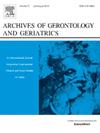主观健康和功能健康相结合的方法如何提高老年人不良事件风险的早期识别?
IF 3.8
3区 医学
Q2 GERIATRICS & GERONTOLOGY
引用次数: 0
摘要
背景:将主观健康和功能健康的评估相结合,可以为老年人健康需求的表征和解决提供更全面的方法。目的探讨功能(adl限制)健康与自评健康(SRH)与不良事件风险(死亡率、adl限制和制度化)的关系。方法样本包括4429名年龄在65岁及以上的参与者,他们来自三个以法国人口为基础的队列,随访时间为20年。创建了一个结合SRH项目和iadl限制的指标来定义四种“健康状态”组:(1)SRH良好,没有iadl限制(参考);(2) SRH较差,无iadl限制;(3) SRH良好,但iadl有限;(4) SRH差,iadl受限。生存模型分别分析了健康状况与死亡风险、adl限制或制度化之间的关系。结果与SRH良好且无iadl限制的参与者相比,没有iadl限制的SRH较差的个体也有死亡、adl限制和制度化的风险增加。此外,那些有IADL限制的人,无论其SRH状况如何,死亡和随后的adl限制的风险至少是前者的两倍。结论:我们的研究结果表明,一旦发现SRH较差,即使没有iadl限制,不良健康事件的风险也会增加。对于有iadl限制的个体,无论其SRH状态如何,这些风险都更高。这些初步研究结果强调,在没有限制的情况下考虑对衰退的感知,有助于在发生不可逆转的损失之前发现早期症状,从而能够针对老年人实施有针对性的预防战略。本文章由计算机程序翻译,如有差异,请以英文原文为准。
How the combined approach of subjective and functional health improves the early identification of the older adults at risk of adverse events?
Background
Combining the assessment of subjective health and functional health may provide a more comprehensive approach to characterize and address the health needs of the older adults.
Objective
To explore the relationship between functional (IADL-limitation) health combined with self-rated health (SRH), and the risk of adverse events: mortality, ADL-limitation and institutionalization.
Methods
The sample included 4429 participants aged 65 years and over from three French population-based cohorts followed up to 20 years. An indicator combining a SRH item and IADL-limitation was created to define four "health status" groups: (1) Good SRH without IADL-limitation (reference); (2) Poor SRH without IADL-limitation; (3) Good SRH with IADL-limitation; (4) Poor SRH with IADL-limitation. Survival models analyzed separately the association between health status and risk of death, ADL-limitation or institutionalization.
Results
Compared with participants with good SRH and no IADL-limitations, individuals without IADL-limitations who reported poor SRH also had an increased risk of death, ADL-limitation and institutionalization. In addition, those with IADL limitations, regardless of their SRH status, had at least twice the risk of death and subsequent ADL-limitations.
Conclusion
Our findings revealed that as soon as perceived a poor SRH, even in the absence of IADL-limitation, the risk of adverse health events increases. These risks are higher for individuals with IADL-limitations, regardless of their SRH status. These preliminary findings emphasize that taking into account perception of decline in absence of limitations can help to identify early symptoms before irreversible losses occur, allowing for the implementation of targeted prevention strategies for older adults.
求助全文
通过发布文献求助,成功后即可免费获取论文全文。
去求助
来源期刊
CiteScore
7.30
自引率
5.00%
发文量
198
审稿时长
16 days
期刊介绍:
Archives of Gerontology and Geriatrics provides a medium for the publication of papers from the fields of experimental gerontology and clinical and social geriatrics. The principal aim of the journal is to facilitate the exchange of information between specialists in these three fields of gerontological research. Experimental papers dealing with the basic mechanisms of aging at molecular, cellular, tissue or organ levels will be published.
Clinical papers will be accepted if they provide sufficiently new information or are of fundamental importance for the knowledge of human aging. Purely descriptive clinical papers will be accepted only if the results permit further interpretation. Papers dealing with anti-aging pharmacological preparations in humans are welcome. Papers on the social aspects of geriatrics will be accepted if they are of general interest regarding the epidemiology of aging and the efficiency and working methods of the social organizations for the health care of the elderly.

 求助内容:
求助内容: 应助结果提醒方式:
应助结果提醒方式:


